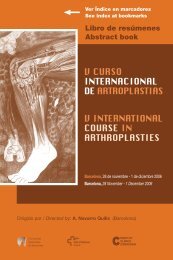Notas / Notes - Active Congress.......
Notas / Notes - Active Congress.......
Notas / Notes - Active Congress.......
You also want an ePaper? Increase the reach of your titles
YUMPU automatically turns print PDFs into web optimized ePapers that Google loves.
MIÉRCOLES / WEDNESDAY<br />
82<br />
hips), and patient dissatisfaction resulting in litigation. The<br />
incidence of LLD varies from 16-96%. A long leg is more<br />
common, more perceived by the patient, and statistically<br />
correlated with reduced hip function scores. Patient perception<br />
of a leg length inequality often correlates poorly with true<br />
radiographic leg length measurements. Patients at risk for<br />
a symptomatic leg length discrepancy include those with<br />
short stature, coxa vara, acetabulae protrusio, preoperative<br />
pelvic obliquity, and preoperative flexion contracture.<br />
Preoperative LLD can occur due to distorted hip anatomy or<br />
false discrepancy due to pelvic obliquity associated with hip<br />
soft tissue contractures or lumbar scoliosis. Post-operative<br />
LLD is most commonly due to intraoperative technical errors<br />
including errors in neck resection, failure to duplicate the<br />
anatomic hip center, accurate choice of prosthetic neck length,<br />
or failure to duplicate femoral offset requiring increased vertical<br />
length to gain hip stability.<br />
Prevention of LLD requires preoperative planning and accurate<br />
intraoperative execution of the preoperative plan. Preoperatively,<br />
true leg length discrepancies can be determined by<br />
tape measurement (anterior-superior iliac spine to medial<br />
malleolus), floor blocks, and assessment of the level of the<br />
iliac crests. Various radiographic measurements are available<br />
typically using a combination of landmarks including the<br />
trans-ischial line, inter-teardrop line, femoral head center,<br />
and the greater and lesser trochanters. Additional, more<br />
precise radiographic leg length assessment options include<br />
orthoroentgenograms and CT scanning. Templating of preoperative<br />
radiographs is critical to determine intraoperative<br />
decisions, such as the level of the femoral neck resection,<br />
choice of prosthetic neck length and offset, and positioning<br />
of the acetabular component. Multiple intraoperative techniques<br />
are available to assist in accurate leg length determination.<br />
Many utilize measurements from fixed landmarks proximal<br />
and distal to the hip joint. These measurements are initially<br />
obtained before the hip is dislocated and repeated after trial<br />
components are inserted to determine intraoperative leg<br />
length changes. An intraoperative radiograph can be obtained<br />
to assure that precise execution of the preoperative plan has<br />
obtained.<br />
Treatment of LLD is based on etiology and patient disability.<br />
Many discrepancies are not perceived by the patient and can<br />
be ignored. Others can be managed with utilization of heel<br />
lifts. Operative treatment options include manipulation of modular<br />
femoral and acetabular components, component revision<br />
in cases of major component malposition, and greater trochanteric<br />
advancement in cases requiring substantial component<br />
shortening.<br />
BIBLIOGRAPHY<br />
1. Bose WJ: Accurate limb-length equalization during total<br />
hip arthroplasty. Orthopedics 23(5): 433-6, 2000.<br />
2. Edeen J, Sharkey PF, Alexander AH: Clinical significance<br />
of leg-length inequality after total hip arthroplasty. Am J<br />
Orthop 24(4): 347-51, 1995.<br />
3. Goodman SB, Huene DS, Imrie S: Preoperative templating<br />
for the equalization of leg lengths in total hip arthroplasty.<br />
Contemp Orthop 24(6): 703-10, 1992.<br />
4. Jasty M, Webster W, Harris W: Management of limb length<br />
inequality during total hip replacement. Clin Orthop Relat<br />
Res 333: 165-71, 1996.<br />
5. Konyves A, Bannister GC: The importance of leg length<br />
discrepancy after total hip arthroplasty. J Bone Joint Surg<br />
Br 87 (2): 155-7, 2005.<br />
6. Maloney WJ, Keeney JA: Leg Length discrepancy after<br />
total hip arthroplasty. J Arthroplasty 19(4 Suppl 1): 108-<br />
10, 2004.<br />
7. Parvizi J, Sharkey PF, Bissett GA, Rothman RH, Hozack<br />
WJ: Surgical treatment of limb-length discrepancy following<br />
total hip arthroplasty. J Bone Joint Surg Am 85-A(12):<br />
2310-7, 2003.<br />
8. Ranawat CS: The pants too short, the leg too long! Orthopedics<br />
22(9): 845-6, 1999.<br />
9. Ranawat CS, Rao RR, Rodriguez JA, Bhende HS: Correction<br />
of limb-length inequality during total hip arthroplasty.<br />
J Arthroplasty 16(6): 715-20, 2001.<br />
10. Ranawat CS, Rodriguez JA: Functional leg-length inequality<br />
following total hip arthroplasty. J Arthroplasty<br />
12(4): 359-64, 1997.<br />
11. Rosler J, Perka C: The effect of anatomical positional relationships<br />
on kinetic parameters after total hip replacement.<br />
Int Orthop 24(1): 23-7, 2000.<br />
12. Shiramizu K, Naito M, Shitama T, Nakamura Y, Shitama<br />
H: L-shaped caliper for limb length measurement during<br />
total hip arthroplasty. J Bone Joint Surg Br 86(7): 996-<br />
9, 2004.<br />
13. Suh KT, Cheon SJ, Kim DW: Comparison of preoperative<br />
templating with postoperative assessment in cementless<br />
total hip arthroplasty. Acta Orthop Scand 75(1): 40-4,<br />
2004.<br />
14. White TO, Dougall TW: Arthroplasty of the hip. Leg length<br />
is not important. J Bone Joint Surg Br 84(3): 335-8, 2002.<br />
15. Woolson ST, Hartford JM, Sawyer A: Results of a method<br />
of leg-length equalization for patients undergoing primary<br />
total hip replacement. J Arthroplasty 14(2): 159-64, 1999.





